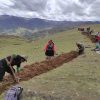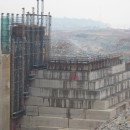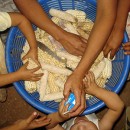Languages
Friday, April 19, 2024
News and Views from the Global South
Peru

Pandemic and Poverty Fuel Child Labor in Peru
In the afternoons he draws with chalk on the sidewalk of a downtown street in the Peruvian capital. Passersby drop coins into a small blue jar he has set out. He remains silent in response to questions from IPS, but a nearby ice cream vendor says his name is Pedro, he is 11 years old, and he draws every day on the ground for about four hours.
Missing Women in Peru – Pain that Never Ends
"They mustn’t stop looking for her," said Patricia Acosta, mother of Estéfhanny Díaz, who went missing on Apr. 24, 2016, along with her five-year-old and eight-month-old daughters, after attending a children's birthday party in Mi Perú, a town in the coastal province of Callao, next to the Peruvian capital.
Bilingual Intercultural Education, an Endangered Indigenous Right in Peru
"I always express myself in Quechua and I don't feel I’m less of a person," said Elías Ccollatupa, 47, who has been a bilingual intercultural teacher for more than two decades in the Chinchaypujio district, one of the nine that make up the province of Anta, in the department of Cuzco, in the southern Andean region of Peru.
Over Two Decades of Impunity for Environmental and Health Disaster in Peruvian Village
"We are not asking for money, but for our health, for a dignified life," is the cry of the people of Choropampa, which lawyer Milagros Pérez continually hears 22 years after the environmental disaster that occurred in this town in the department of Cajamarca, in Peru´s northern Andes highlands, on the afternoon of Jun. 2, 2000.
Rivers Have no Borders: The Motto of Their Defenders in Peru
"Water is part of our culture, it is intrinsic to the Amazon," said José Manuyama, a member of a river defense committee in his native Requena, a town located in the department of Loreto, the largest in Peru, covering 28 percent of the national territory.
Women Politicians in Peru Face Severe Harassment, Discrimination
Women entering the political arena in Peru face multiple obstacles due to gender discrimination that hinders their equal participation, which can even reach the extreme of political harassment and bullying, in an attempt to force them out of the public sphere.
Women Bear the Brunt of Post-COVID Employment Woes in Latin America
The COVID-19 pandemic did not hit everyone equally and employment has shown a clear gender-differentiated impact. Two years after the start of the pandemic, it is more difficult for women than men to recover their jobs, and this is clearly reflected in Latin America.
Rural Women in Peru Seed Water Today to Harvest It Tomorrow
"When I was a little girl we didn't suffer from water shortages like we do now. Today we are experiencing more droughts, our water sources are drying up and we cannot sit idly by," Kely Quispe, a small farmer from the community of Huasao, located half an hour from Cuzco, the capital of Peru's ancient Inca empire, told IPS.
No Vaccine for the Pandemic of Violence Against Women in Latin America
Despite significant legal advances in Latin American countries to address gender-based violence, it continues to be a serious challenge, especially in a context of social crisis aggravated by the covid-19 pandemic, which hits women especially hard.
For Girls, the Biggest Danger of Sexual Violence Lurks at Home
"During the pandemic, sexual violence against girls has grown because they have been confined with their abusers. If the home is not a safe place for them, what is then, the streets?" Mía Calderón, a young activist for sexual and reproductive rights in the capital of Peru, remarks with indignation.
Sowing Water by Restoring Ancient Ditches in the Peruvian Highlands
In the highlands near the capital of Peru, more than 3,000 metres above sea level, ageold water recovery techniques are being used to improve access to water for 1,400 families, for household consumption and for crops and livestock.
Indigenous Farmers Harvest Water with Small Dams in Peru’s Andes Highlands
A communally built small dam at almost 3,500 meters above sea level supplies water to small-scale farmer Cristina Azpur and her two young daughters in Peru's Andes highlands, where they face water shortages exacerbated by climate change.
Coronavirus Hasn´t Slowed Down Ecological Women Farmers in Peru’s Andes Highlands
It's eight o'clock in the morning and Pascuala Ninantay is carrying two large containers of water in her wheelbarrow to prepare with neighbouring women farmers 200 litres of organic fertiliser, which will then be distributed to fertilise their crops, in this town in the Andes highlands of Peru.
Thermal Houses Keep People Warm in Peru’s Highlands
Thirty families from a rural community more than 4,300 meters above sea level will have warm houses that will protect them from the freezing temperatures that each year cause deaths and diseases among children and older adults in this region of the southeastern Peruvian Andes.
Youth in Latin America Learn About Paths to Clean Energy
Young Peruvians plan to take advantage of the knowledge acquired in Brazil's semi-arid Northeast to bring water to segments of the population who suffer from shortages, after sharing experiences in that ecoregion on the multiple uses of renewable energies in communities affected by climatic phenomena.
Latin American Rural Women Call for Recognition and Policies
Rural women in Latin America play a key role with respect to attaining goals such as sustainable development in the countryside, food security and the reduction of hunger in the region. But they remain invisible and vulnerable and require recognition and public policies to overcome this neglect.
Community Work Among Women Improves Lives in Peru’s Andes Highlands
At more than 3,300 m above sea level, in the department of Cuzco, women are beating infertile soil and frost to grow organic food and revive community work practices that date back to the days of the Inca empire in Peru such as the "ayni" and "minka".
Breaking the Cycle of Child Labor in Peru
Most laborers in Peru are forced into a vicious cycle by circumstance. Faced with low-paying, high-intensity work, they have no choice but to make their children work as well. Having spent their lives neglecting education for labor, those children in turn grow up with no options for income besides low-paying, high-intensity positions - and so on. But in classrooms across one region, a handful of teachers are trying to break that cycle while the children are still young.
Peru’s Poor and Disabled Struggle in the Shadows
Eighty percent of the world’s disabled live in developing nations, according to a report by the United Nations. Their identities, lives and stories are of course varied – but what isn’t is the stigma and lack of resources they face.
Women Farmers in Peru Bring Healthy Meals to Local Schools
Getting children and adolescents to replace junk food with nutritious local organic foods is the aim of a group of women farmers in a rural area of Piura, on Peru’s north coast, as they struggle to overcome the impact of the El Niño climate phenomenon.
For the Rural Poor of Peru, the Social Agenda is Far Away
“The day will come when people do not have to go to the cities to overcome poverty," says Elmer Pinares, mayor of an Andean highlands municipality in Cuzco, in southern Peru, where malnutrition and lack of support for subsistence farming are among the main problems.« Previous Page — Next Page »












